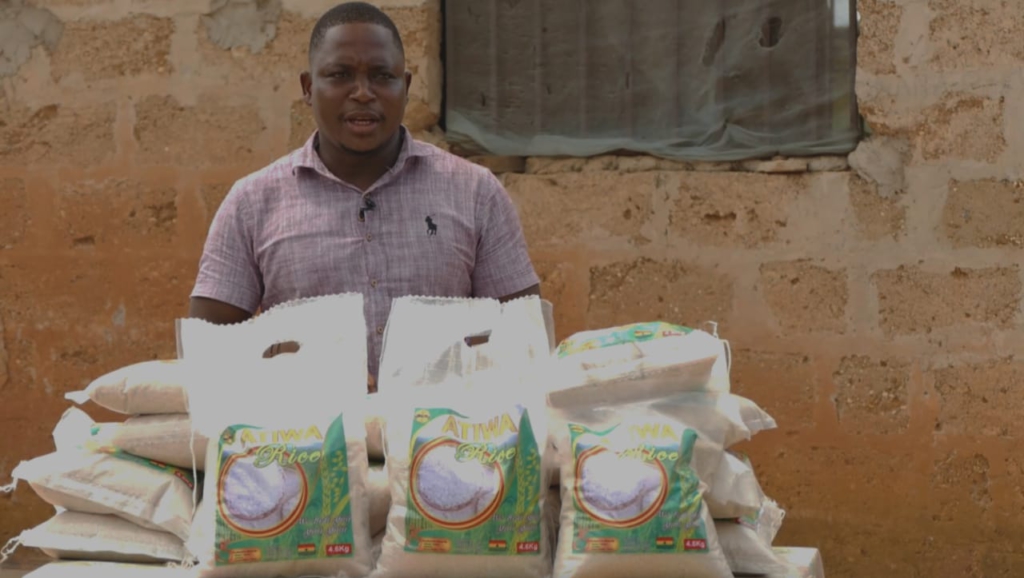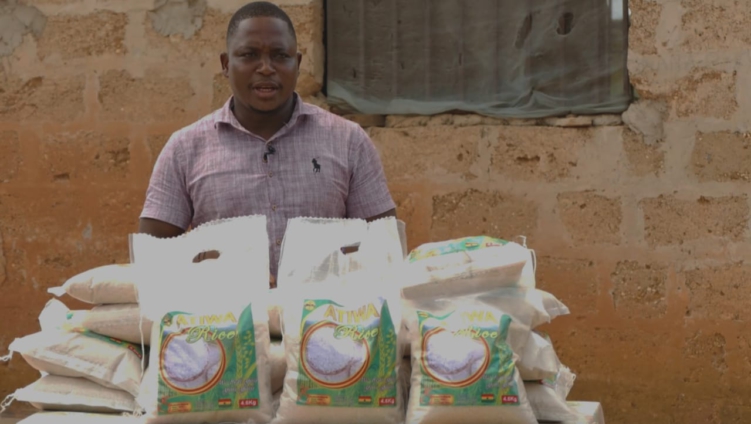Some rice farmers in the Atiwa District of the Eastern Region say productivity on their farms has improved following their decision to plant improved seeds.
Through the “Public-Private Partnership for Competitive and Inclusive Rice Value Chain Development” project, AGRA has supported the farmers with improved seeds, village-based advisors (VBA) have been trained to support them, and linkages have been created between farmers, input dealers, and markets.
Godfred Mensah Amenyo, a farmer said, “the inputs are helping us increase productivity. I got 65 bags of rice from my 4-acre field this year. That same size of farm previously gave me only 20 bags."
“It is very encouraging. Through the project, poverty has gone down,” Reindorf Nakuja, a VBA said when some project officials visited the district.
Generally, productivity on rice farms has increased from between 1.8 and 2.5 metric tonnes per hectare to between 3 and 5 metric tonnes per hectare in some project communities.
Atiwa East District Director of Agriculture Samuel Ofosu said, “We’ve been able to increase our production to even 5 tonnes per hectare as of the last production season. We’ve also developed the Atiwa Rice brand. So marketing is not a challenge because we have been able to bag some of our rice.”
Through the Ghana Rice Project, more than 3,000 metric tonnes of certified and improved AGRA rice seeds produced by the Crop Research Institute in Kumasi have been multiplied and distributed to farmers.

Also, more than 200 agro-dealers and about 256 village-based advisors have been trained to support farmers.
The capacity of more than 46 rice millers has been built. Hundred thousands of dollars have been invested in farm infrastructure including, in the Botanga Rice Irrigation Scheme for the benefit of farmers.
Challenges with Ghana’s rice sector
Rice remains one of Ghana’s major staples. On average, every Ghanaian consumes about 63kg of rice annually. According to the Oxford Business Group, in 2017 alone, 1.3 million tonnes of rice were consumed in Ghana. The only problem is that out of that, only 720,000 tonnes representing 55% were produced in the country.
The rest were imported from Thailand, Vietnam, India, and other nations. The Group estimates that in 2015 alone, Ghana spent US$1.2 billion in foreign exchange importing rice. On average, Ghana spends over US$600 million annually on rice imports.
Minister for Food and Agriculture, Dr. Owusu Afriyie Akoto said “It’s really scary that we have lands in Central, Ashanti, not to talk of the Savannah zones which can feed almost half of West Africa, and we are spending almost half of our major cocoa export proceeds (US$1 billion) on importing rice. It’s a disaster.”
In 2018, Alliance for a Green Revolution in Africa (AGRA) rolled out the project in partnership with Hopeline Institute, John A. Kufuor Foundation, Sparkx Farms, Volta City Farms, and the Ministry of Food and Agriculture.
The 2 million Euros project seeks to enhance the capacity of over 128,000 smallholder rice farmers across the country to ensure the efficiency and profitability of operations.
It also seeks to strengthen and expand small-holder farmers’ access to input and output markets for increased production and income.
The project also aims to encourage increased consumption of Ghana rice.
Latest Stories
-
Baby abandoned in manhole in Tema Community 1
21 seconds -
We’ll establish fiscal council to rein in excessive borrowing – Finance Minister
7 mins -
Mortuary workers issue fresh strike threat
11 mins -
‘Lapses in banking system are not unique’ – John Awuah on managing fraud in Ghana’s Banks
19 mins -
Bawumia confident of victory in 2024 election
53 mins -
Strengthening audit institutions essential for tackling fiscal mismanagement – Domelevo
1 hour -
Healthy Aging: The Role of the Gut Microbiome and How Diet Can Help
1 hour -
Seek medical care, diagnosis for breast cancer – Dr Abiti to women
1 hour -
Hardship: Men now collect marriage list from different families to get cheapest – Report
1 hour -
‘If you’re looking for trouble, you’ll get it,’ Falz tells VeryDarkMan
1 hour -
Paramount Chief of Avenor grateful to NPP, calls for completion of Agenda 111 project
2 hours -
Bawumia commissions ultramodern office complex for Ho Municipal Assembly
2 hours -
Bawumia declares NPP’s infrastructure record unmatched
2 hours -
Importers face duty on Electric Vehicles despite gov’t’s exemption promises
2 hours -
4 additional Democracy Hub protesters discharged
2 hours

